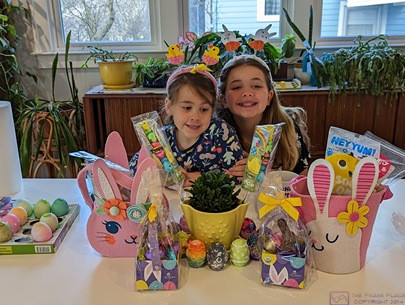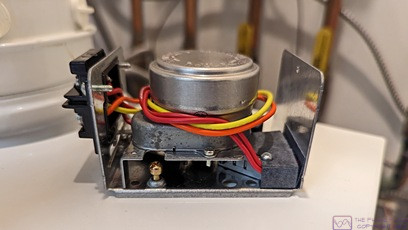[ In addition to the narrative, this post contains 17 photos with captions. ]
MONDAY 3 – TUESDAY 4 April
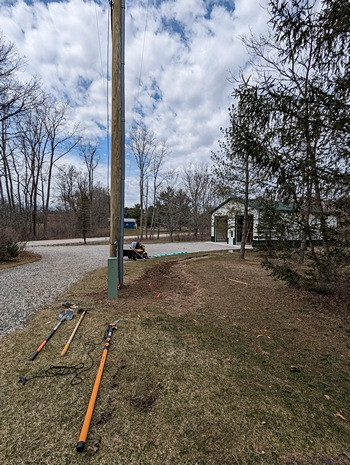
The conduit trench that runs form the new utility pole along the inside curve of the driveway to the meter box at the SE corner of the barn. Various tools are out as I get ready to move some dirt around to better fill-in the trench.
With all of the rain that came in March I finally had a day to continuing working on the trench for the conduit carrying the large electrical conductors from the pole to the barn meter box. The soil was damp, so it was easy to dig but heavy to move. I placed some of our surplus stacking landscape blocks in the trench every 5 feet of so to help retain the soil that I moved into the trench from either side.
The green bags in the following photo are 40 lb. topsoil, but I had been advised against using them as fill as it just washes downhill. At some point I will probably get out the garden tiller and try to work this soil into the clay, but I would really like to wait until Phil can get back here and correct some of the grading.
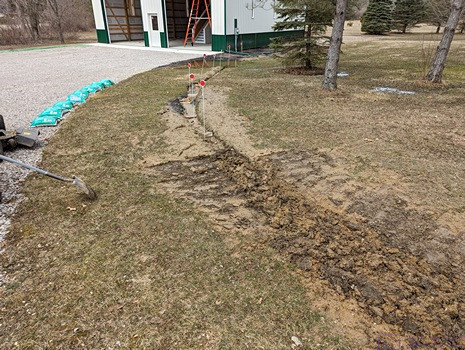
I have managed to shovel/scrape most of the soil (clay dirt, really) from along the sides of the upper end of the trench into the cut, leaving it mounded up somewhat as it will eventually settle.
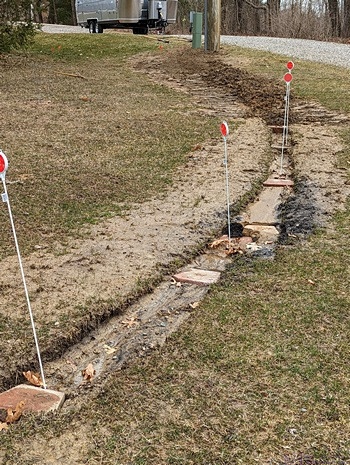
The stackable landscaping blocks are visible in the trench. I used them as partial fill and to stop erosion of the newly place soil in the trench.
WEDNESDAY 05 – WEDNESDAY 12 April
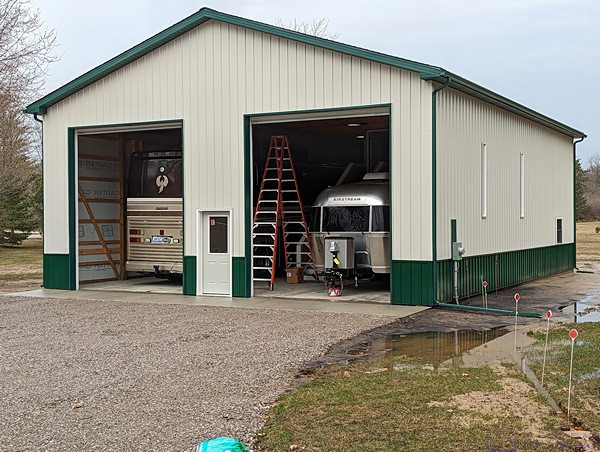
The converted coach and the travel trailer in the barn. We put them inside because the weather forecast included the possibility of large/damaging hail. “Technically, they should not be in there as we do have the occupancy certificate yet (I need to finish the wiring first), but any fine we might get would be miniscule compared to the damage that large hail could do to either/both of our RVs. We did get pea-sized hail, along with lots of rain and wind, but south of us there was ping-pong ball sized hail that destroyed fields of crops and badly damaged vehicles. Note the standing water just off the right edge of the driveway at the SE corner of the barn. I am waiting for our grading and excavating guy to squeeze us into his incredibly busy schedule and take care of the drainage.
Linda (Ama) was away from the house from mid-day on the 5th until late evening on the 12th. She was providing live-in child care for our two younger grand-daughters while their mommy and daddy took a 1-week adult vacation to Iceland. I drove down on the 5th to help get the 10-year-old to her rock-climbing class and then back home for dinner, before returning home myself. I went down again on Saturday the 8th in time for dinner and stayed the night. What fun that was! Finally, I drove down on Wednesday the 12th to pick the 10-year-old up from school, take her to her rock-climbing class, and then get the two of us to the Ann Arbor area Buddy’s Pizza to meet up with Ama and the 4-year-old for dinner. When I wasn’t doing those errands, I was home working on the barn, and other things. I will get to those momentarily, but first, some highlight photos of the Ann Arbor events.

Sadie (L) and Madeline (R) with their aunt Meghan (C) at the butterfly exhibit at Meijer Gardens in Grand Rapids, Michigan on Friday, April 7. (Photo by Linda.)
PXL_20230407_145529564_307x408(L)… A lovely photo of a beautiful butterfly. (Photo by Linda.)

Saturday morning means ice skating lessons. “Mads” (with her arms and one leg extended) seems to be doing pretty well. (Photo by Linda.)
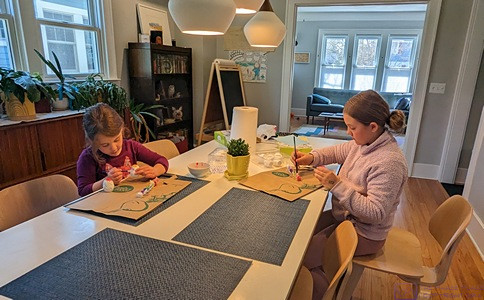
Easter weekend was upon us so on Saturday afternoon the girls decorated ceramic eggs. (Photo by Linda.)
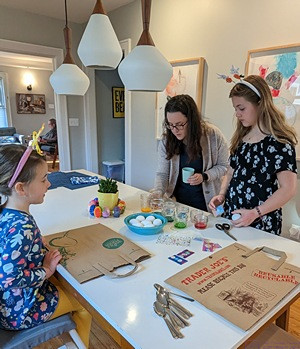
On Easter Sunday, aunt Meghan came over and the girls decorated actual eggs. The Easter Bunny showed up while the girls were not looking, and the eggs got hidden in the back yard. (Photo by Linda.)
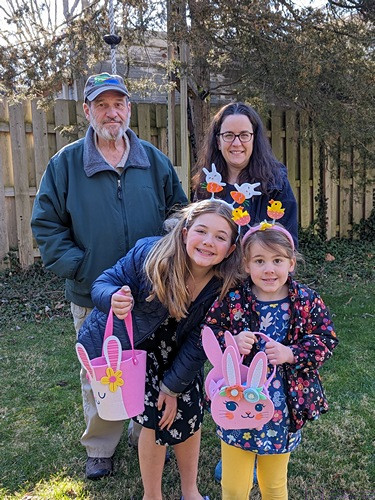
Here I am with the crew after a successful egg hunt. Note that one or two eggs disappeared between the time the Easter Bunny hid them and the girls went looking for them. A squirrel was spotted from the house carrying at least one of them away. (Photo by Linda.)
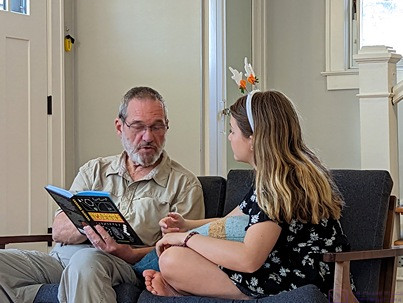
Apa (me) and “Mads” discussing something in the her recently acquired book on the history of Algebra. She’s 10-1/2 years old. (Photo by Linda.)
The main “other thing” of particular note, was that the basement zone of our hot-water baseboard heating system quit working. Our system has three zones, and the other two were working normally, so that strongly suggested that the zone valve had failed.
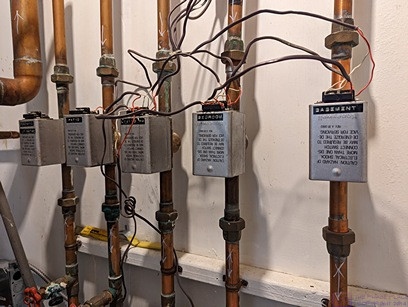
The hot-water baseboard heating system originally had 5 zones, each controlled by one of the zone valves shown in this photo. The basement zone valve is on the far right. The next two are for the main part of the house and the bedrooms. The last two originally served a zone for the breezeway (now our library) and the water-heater, which is just out of the photo to the left. The library zone was decommissioned when we had the new natural gas furnace installed in early 2016. The water heater zone was also decommissioned at that time as the Bosch furnace controls the hot-water tank/function directly.
The zone valves are a Honeywell Home V8043F1036/U Motorized Valve. It has a 24VAC 50/60 Hz motor with an integral end switch and the 1/4-turn brass valve has 3/4″ sweat fittings assembly. The motor-actuator engages a small shaft that protrudes from the valve. There is also a lever on the motor actuator that is supposed to allow the valve to be opened manually and secured in that position, but the lever would not budge. Either the motor or the valve had seized, but I wasn’t sure which one.
Well … it so happened that I had a complete spare zone valve on the shelves in the furnace room. It was still in a box with directions, albeit the box was a bit tattered and the directions were in pretty rough shape.
The valve assembly came with the house, and had probably been there for many years before that. Fortunately, it was fairly obvious that the motor-actuator could be separated from the valve by removing two small screws.
I shut of the furnace (“boiler”) and then shut off the power to the entire system, which is both 120VAC and 24VAC. I took a photo of how the wires were currently connected to the existing motor-actuator and then carefully removed them from the terminal screws. I removed the retaining screws from the existing unit and slid it off, with some difficulty. I was able to turn the valve shaft easily, but I could still not move the manual lever on the motor unit. Problem isolated.
I separated the motor-actuator on the “new” zone valve from the valve body, checked that I move it by hand (I could) and attached it to the existing valve body. I was able to open it manually, so I reconnected the wires, turned the power back on, and then turned the furnace on. I then turned the basement thermostat on and went away to do other things, one of which was to see if I could purchase replacement valve assemblies to keep on hand. As it turned out, I was able to order two spare valve units on Amazon.
The reason for the wait was that this particular Bosch unit has an outside temperature sensor, which results in a strange system behavior during the spring. At this time of year the sub-surface temperature of the earth around the house is still cool and thus the basement tends to be cool as well (most of it is not very well insulated). But because the temperature outside is above some limit, the furnace refuses to operate any of the space heating zones. It still makes hot water; it just won’t heat the house. That’s not a problem upstairs where it tends to be warmed and we also have a forced-air heat pump, but for a period of time each spring the basement just ends up colder than I would like. Worst case, I have been known to close the doors to my office and run a small fan-heater.
Another important “other thing” was that I finally had a chance to talk to the neighbor (Rebecca) across the street about Cabela (the cat). Cabela is a lovely female cat that belongs to Dave and Rebecca (and their kids) but Cabela is afraid of their dog, Kenai, and will not go in their yard when the dog is outside, which is most of the day and evening. (Cabela was actually hanging around our house all winter, and it was then that we learned she belonged to the neighbors). As a result, Cabela spends most of her time around our house and in our yard, but (supposedly) goes home at night where she is fed and has shelter on their back deck.
Cabela does not come in our house and we are not adopting her. She is not ours, and we have no plans to get any more pets unless/until we are no longer doing any extended traveling. The main reason for the conversation was to make sure they were aware that Cabela was hanging out at our place, and that both we and they were OK with the situation. I also let her know that I give Cabela some food (dry kibble) in the morning and wanted to make sure that was OK with them. It was a very friendly chat, and yes, they had seen her over there, and no, it was not a problem. If anything, they did not want us to feel like we had to take care of her. I assured her that we did not, and since we were now kitty-less, we enjoyed being able to interact with her, without really being responsible for her.
Back on the barn project, the major tasks facing me were the wiring, and then the relocating of “things” (many things) from the garage to the barn shop and storeroom. A “minor” task was that I wanted to paint the two exterior walls of the shop/storeroom that are inside the barn, but this had to be finished before I could run some of the conduit. (I hope that makes sense. The shop and storeroom are a 2-story enclosed space in the right rear corner of the barn. The east and north walls are part of the shell of the barn. The other two walls (south and west) are inside the barn. All four walls are insulated with closed-cell foam. There is also closed cell foam above the ceiling of the storeroom, and rigid foam under the portion of the concrete floor that constitutes the floor of the shop.)
I have been moving and staging tools and materials in the barn shop in advance of the painting and wiring work, and decided I needed to move all of it somewhere else as I will be doing a lot of wiring in the shop. The storeroom was the obvious (?) place to move much of it, even if only temporarily.
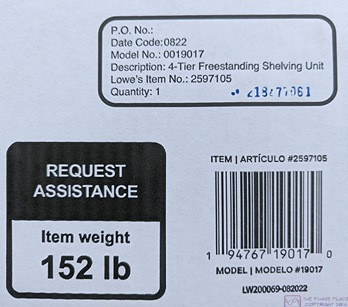
This photo is out of sequence, but has the critical information about the heavy-duty shelving units. With packaging they were more like 160 lbs. each. I had to open each box and carry most of the parts up to the storeroom individually.
With that in mind, I checked around at Lowes and The Home Depot and decide to get two metal shelving units for the barn storeroom. I bought two KOBALT, 4-shelf, black, units, each 77”W x 72”H x 24”D; 152 lbs. each including the box. An associate at Lowes helped me load them into the F-150, but I had to unload them by myself.
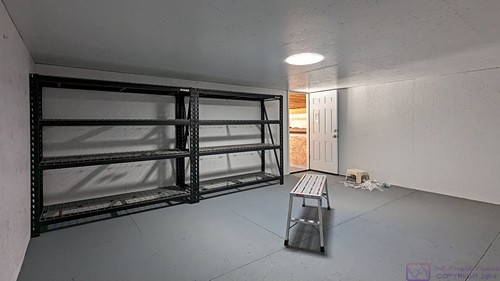
As shown in this photo, I originally placed them against the south wall of the storeroom. I eventually relocated them to the north wall.
The instructions indicated an assembly time of 20 minutes (not including the unpacking). Yeah, right. I had to unpack them and carry them up to the storeroom in pieces. Unloading, unpacking, and transporting the pieces to the storeroom took about hour for each shelving unit (I did them one at a time). My assembly time for the first unit was over two hours. The second unit went a bit faster, but not that much.
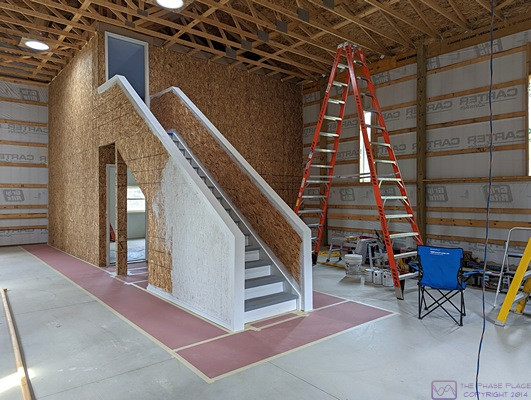
A view of the staircase to the storeroom above the shop as I prepare the area to finish priming and painting the walls. Note the red rosin paper on the floor to protect the concrete from errant paint.
A combination of illness, weather, trying to process photos and write blog posts about our Panama Canal cruise, and unexpected home projects had temporarily delayed getting work done on the barn, but by mid-April the pieces were finally falling into place.
…

